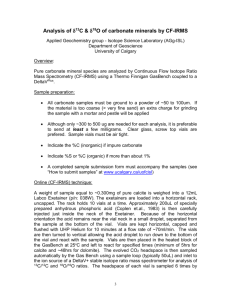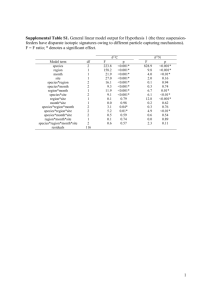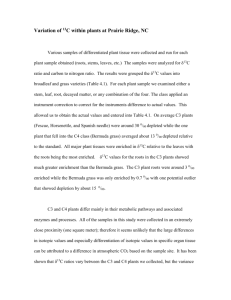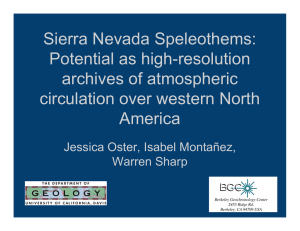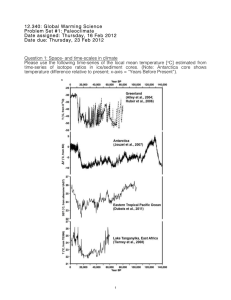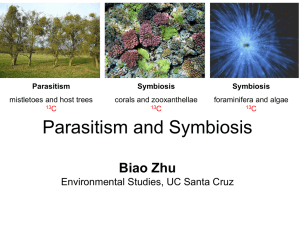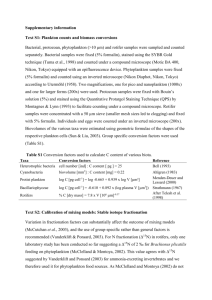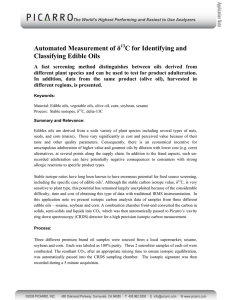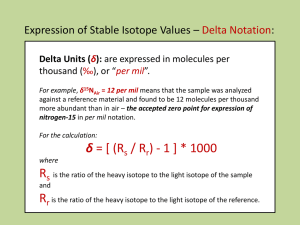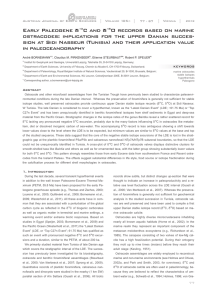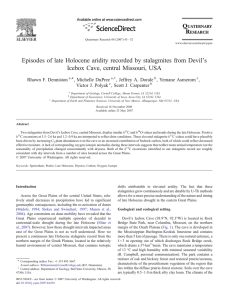Parasitism and Symbiosis: isotope effects in mistletoe and foraminifera
advertisement
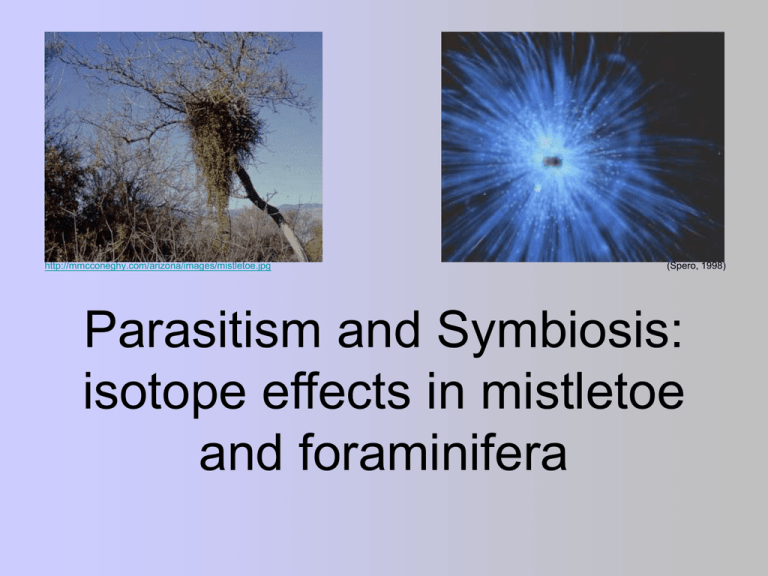
http://mmcconeghy.com/arizona/images/mistletoe.jpg (Spero, 1998) Parasitism and Symbiosis: isotope effects in mistletoe and foraminifera Carbon isotope composition, gas exchange and heterotrophy in Australian mistletoes Marshall, Ehleringer, Schulze, and Farquhar, 1994 • δ13C of plant tissue related to photosynthetic gas exchange by this equation: • δ13Cplant=δ13Cair-a-(b-a) (ci/ca) • • • • δ13Cplant= carbon isotope of tissue δ13Cair= atmospheric CO2 (-8‰) Ci=intercellular CO2 concentration Ca=atmospheric CO2 concentration (look familiar?) It would make sense for parasite 13C to be intermediate between host plant carbon (lower ci) and mistletoe photosynthate. • δ13Cparasite= (A[δ13Cair-a-(b-a)(ci/ca)]+Ecx δ13C)/A+Ecx • • • • A= rate of photosynthesis E= rate of transpiration Cx= [carbon] in xylem sap δ13C= isotopic ratio of xylem carbon (=host tissue) Due to leakiness, mistletoes expected to have lighter δ13C, but remain heavy if taking carbon from host. • Xylem carbon concentration was estimated from measured photosynthetic rate (A), and transpiration rate (E) • Cx= (AH)/E(1-H) • H is a measure of proportional heterotrophy • Large differences in the A/E ratio between host and parasite should be associated with similar differences in ci/ca; causing isotopic difference ~2X difference in A/E Host Average δ13C=-26.81+0.25‰ Parasite Average δ13C=-28.67+0.23‰ (Marshall et al., 1994) Measured δ13C plotted against δ13C predicted with basic equation: δ13Cplant=δ13Cair-a-(b-a) (ci/ca) “calculated mistletoe” includes contribution of host xylem carbon (Marshall et al., 1994) Carbon and nitrogen isotope ratios, nitrogen content and heterotrophy in New Zealand mistletoes Bannister and Strong, 2000 • Smaller difference in isotopic ratios of host organisms and parasites Host Average δ13C=-28.89+-0.12‰ Parasite Average δ13C=-29.51+-0.10‰ Australia New Zealand •Arid, water limited •Mistletoe forced to maintain low water potential and high transpiration rate to take water from stressed host Temperate climate drives similar physiology in host and mistletoe leading to similar isotopic ratios… Intraspecific stable isotope variability in the planktic foraminifera Globigerinoides sacculifer: Results from laboratory experiments Spero and Lea, 1993 (Spero, 1998) Benefits of symbiosis in foraminifera •Energy from photosynthesis •Ability to assimilate dissolved inorganic nutrients •Metabolite removal NH4+ PO43- (Spero, 1998) δ13C: As irradiance (and algal activity) increases, δ13C ratios increase δ18O: As irradiance (and algal activity) increases, δ18O ratios decrease Test size is dependant on light levels Ca2+ + 2HCO3- -> CO2 (to photosynthesis) +CaCO3 (calcite) + H2O Goldilocks and the three Globigerinoides Largest individual tests (>750microns) give most accurate isotopic ratios for intercore comparison of δ13C , because all organisms grew under similar, Pmax conditions. Medium sized tests were calcified under wide range of sub-Pmax conditions, and will yield variable δ13C values. Small tests belonged to forams living in the mixed layer/thermocline boundary where there is low light and heterogeneous δ13C conditions. δ13C=1.5‰ variation from light level changes http://webpersonal.uma.es/~FSL/imag/Gnoides.sacculifer.jpg Punchline: Symbionts on spines or within rhizopodial web preferentially uptake 12C, creating a microenvironment enriched in 13C that surrounds the test calcifying environment. (large kinetic fractionation associated with ribulose biphosphate carboxylase enzyme) (Spero, 1998) Mechanism of δ18O depletion with increased symbiont Photosynthesis: a possible explanation •Rate of calcite precipitation is positively correlated with light intensity •High calcification rates imply rapid reaction cycles of CO2 + H2O <-> H2CO3 and rapid exchange of CO2 across membranes •This does not allow for complete equilibration between cellular and seawater carbon reservoirs •So the resulting calcite is depleted in δ18O as compared to seawater values Gametogenic calcite δ18O effects Pre-gametogenic Release of gametes δ18O values enriched relative to seawater, about 2‰ Gametogenic calcite (Spero, 1998)
